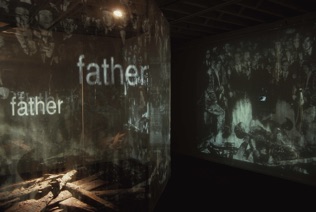ARTS PORTFOLIO
INTRODUCTION

Alice Thorson,
New Art Examiner / Kansas City Star
On first encounter, the diverse artistic output of Baltimore-based artist Sherwin Mark seems to defy generalization. Ranging from dust sculptures, swept into being from the debris on his studio floor, to ambitious multi-media works exploring the terrains of language, photography, and human behavior. Mark's oeuvre bespeaks a volatile, quicksilver intelligence of seemingly unpredictable focus.
He collects — varicolored bars of soap which he photographs in a row. He wraps — the odd, valueless found object in a raggedy blanket, or a trio of World War II gas masks in handkerchiefs. He writes — ostensibly meaningless declarations that he takes to strangers' houses and asks them to sign. He sculpts, paints, photographs, performs, appropriates and gives away.
Mark's current exhibit takes a selected long view of his creative activity since 1975, the year he graduated from Michaelis School of Fine Art at the University of Cape Town, South Africa. Although Mark left his native country in the late 1970s— living in The Netherlands and Israel before moving to Baltimore in 1981 — his perceptions and attitudes and the questions he chooses to explore have remained integrally rooted in the South African experience.
Compassionate whites in (pre-1994) South Africa daily confront an array of moral catch-22s issuing from their de facto privileged status under the apartheid system. Much of the country's drama and literature explores the wrenching dilemmas that demonize any human relationship that crosses the race and color barriers set up by law. Another recurrent theme is the pervasive sense of paralysis and helplessness ensuing from the realization that any action taken to ameliorate the cruelties and injustices of this system in effect functions to prolong it.
The gaps between intention and effect, perception and reality, beliefs and action are themes that surface frequently in Mark's work. If there is a constant to emerge from his diverse activities and objects it is his delight in destabilizing the identities we impart to things and those we assume as individuals.
Mark revalues found objects and worthless castaways by giving them as gifts, so turning them into talismans of generosity. Propped open and encased in a plexiglass box, a fragment of a duvet cover assumes the sinister air of a Klansman's hood. Snippets of Scotch tape touched with paint by the artist are endowed with sculptural interest: no longer transparent and taut as is their nature, they sag and crackle in a variety of intriguing configurations which Mark has preserved in a series of photographs.
In positing identity as a function of context rather than the sum of intrinsic qualities. Mark's approach to objects is very much in the Duchampian tradition. Equally as fascinating are his numerous performance and installation works representing an extrapolation of this attitude into the realm of individual identity and self-definition. Mark takes the existential position that it is not the beliefs held, but the actions taken in a given situation that defines the person.
The exhibit includes several examples of Mark's "scenarios" comprising small figurative tableaux addressing the ethical conundrums endemic to existence in South Africa. Other objects and images on display represent versions of multimedia installation and performance pieces he has previously mounted or enacted elsewhere. In "Statement of Fact" (1975) the artist provoked a situation; in "Remembering Forgetting" (1990-1991), he invokes one, utilizing an appropriated image showing a lynch mob posing for a photograph. In different ways both works highlight human desire for, in Mark's words, "evidence of their existence." In similar fashion, "the context and consequences of their situation [are] entirely set aside."
Mark has received numerous invitations to exhibit his ambitious multimedia installations. He was one of five artists selected to exhibit in "Maryland Invitational 1990" at the Baltimore Museum of Art, and has exhibited major pieces at the Snug Harbor Cultural Center in Staten Island, the Dadian Gallery in Washington, D.C., Maryland Art Place in Baltimore, Arlington Arts Center, and The Alternative Museum in New York. His works appear in several private collections, The Museum of Modern Art Tel Aviv Israel.